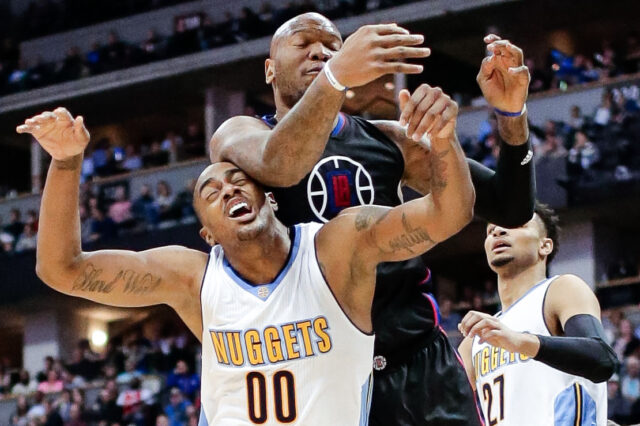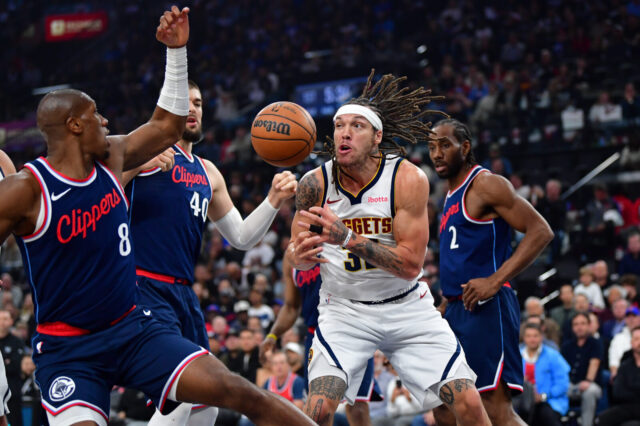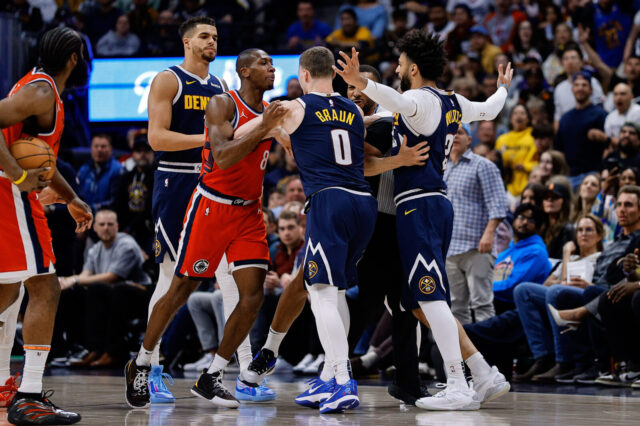A few days ago, Frank Urbina of Hoops Hype released his personal list of the Top 22 small forwards in the NBA heading into the 2021-22 season. Before reading this, I urge you to read that to gain a national perspective on the small forward position in the NBA today.
Spoilers: Michael Porter Jr. ranked 10th, a fair placement based on the strength of the position, Porter’s recent rise, and the expectation of improvement heading into next year. Porter appeared ahead of some impressive names, including DeMar DeRozan (11th), Gordon Hayward (12th), Jerami Grant (13th), and Mikal Bridges (14th). Nuggets fans should be pleased with that, as it shows a level of healthy respect for Porter’s game at one of the strongest position groups in the NBA.
And it’s unsurprising. Very few players in the NBA have ever averaged 19.0 points and 7.3 rebounds per game on Porter’s level of shooting efficiency. 54.2% from the field, 44.5% from three, and 66.3% true shooting are absurd levels for even the best shooters, and Porter is close to solidifying himself as one of the best shooters in the NBA if he has another season scoring the way he did last year.
But the questions surrounding Porter don’t generally stay with the here and now. They usually persist into the future, the unknown, what ever is to come for Denver’s third star. After proving he can handle what the Nuggets and opponents threw at him during the 2020-21 season in just his second year, there’s a lofty level of excitement for what happens next.
For Porter to become a Top 10 small forward after just his Age 22 season should be considered an achievement. Given that Porter missed nearly his entire freshman season in college and his entire rookie season while recovering from back surgeries, Porter has had little time to and experience to develop and improve his skill set. In his actual rookie season, Porter played just 672 minutes before the bubble in August and September, and then he was thrown into the fire during those months and expected to produce at a playoff caliber level.
Then, he had his first full season in 2020-21 while still trying to figure out his role on the Nuggets roster. Things got better midway through, but there was a significant chunk of time that saw Porter struggle both offensively and defensively. He needed to learn how to be himself, but he also needed to assimilate his game into what the Nuggets did best. Porter also missed 10 games due to COVID health and safety protocols which delayed the blending process. For awhile, those two factors were entirely misaligned, and it wasn’t until March midway through the year when things began to click into place for both player and team.
This content is no longer available.
The drastic nature of those splits was aided by the unfortunate injury absence of Jamal Murray, but even while Murray was still playing prior to April 12th, Porter was still cruising, averaging 20.5 points on highly efficient shooting splits as the third option behind Nikola Jokić and Murray. The Nuggets had found their rhythm, and Porter had found his. The team was in lockstep for awhile, so much so that even when Murray went down, followed by Monte Morris, Will Barton, AND P.J. Dozier, the team still had a strong formula for wins led by Jokić and aided by Porter. The 22-year-old had found his place in Denver’s rotation at long last.
Fast forward to the 2021-22 season, and Porter is listed as the final name on Hoops Hype’s Top 10 small forwards entering this year. Despite the strong quality of the names ahead of him, Porter has some upward mobility as well. Brandon Ingram and Jaylen Brown are quality young scorers in their own right with other skills (playmaking for Ingram, defense and versatility for Brown) that currently cast them ahead of Porter. Still, there’s no reason that Porter can’t continue to take steps forward and surpass those two, maybe even Jimmy Butler or Khris Middleton as well, though that seems ambitious for at least the time being.
It’s exceedingly unlikely that Porter will reach the pinnacle at the position next year. Names like Kevin Durant and LeBron James adorn the top of the list. Luka Doncic, who is still just 22 years old himself, is unlikely to fall back now that he’s entrenched as a perennial MVP candidate. The same goes for 23-year-old Jayson Tatum and 31-year-old Paul George, the former showing no signs of slowing his upward trajectory and the latter showing no signs of slowing down.
Still, it’s important to remember where each of those players were in their Age-22 seasons. James took his 2006-07 Cleveland Cavaliers to the NBA Finals as the leader of that squad, though he was swept by Tim Duncan and the San Antonio Spurs. Durant was leading the NBA in scoring for the second season in a row during his Age-22 season in 2010-11. Doncic hasn’t technically had his Age-22 season yet. That comes this year, and it’s terrifying to imagine what Luka could be for the next several years.
Here’s a list of the entire Top 10 and how they performed during their Age-22 seasons:
This content is no longer available.
Right away, the clear separation for Porter comes with his shooting efficiency. It’s a slightly different era, far more efficiency forward, but Porter’s shooting ability will be what makes him a great player for years to come. The 6’10” shooter spent a week this offseason training with Stephen Curry, the very best shooter the sport has ever seen. He’s a pretty good player to learn from to understand the ins and outs of cutting, relocating, shooting though traffic, and shooting with pace and range. There’s no reason to believe Porter will go backwards in that regard as long as he maintains his high level of confidence in his own abilities.
There are still tangible ways he must improve for the shooting talent to be fully realized. The handle has to be tighter, because despite Porter’s ability to shoot over anyone in the NBA, he’s decidedly less effective when opponents crowd his airspace and don’t let him set up for jumpers in the first place. This was one way both the Portland Trail Blazers and Phoenix Suns attacked him in the playoffs this past season, and because Denver didn’t have Jamal Murray to ease that burden, the entire team struggled to operate against the Suns. If Porter wants to become the next great small forward, he has to improve his ball handling. It will force defenses to take a step back more consistently.
The next key factor: reading the floor and making the right play. Someone as talented as Porter doesn’t need to be much of a passer, especially playing next to Nikola Jokić; however, defenses will send an extra defender at Porter consistently unless he proves that he can handle double teams well. Making passes to open teammates, understanding what will happen if certain actions occur, and thinking the game at a higher level will set him up incredibly well as a scorer going forward.
Finally, the defense. Nobody really questions LeBron James and Kevin Durant as defenders anymore, possibly because it would be dumb, but also because those two proved they could defend at high levels when they set their minds to it. The same could be said for George, Tatum, Kawhi Leonard when healthy of course, Butler, and Middleton. Those are two-way players. Luka is so good offensively that it may not matter what he does on defense, but even he is starting at a higher baseline than Porter. If Denver’s starting small forward can continue learning to use his size and athleticism in impactful ways defensively, he will solidify his placement on this list and making rising up the ladder a legitimate possibility.


